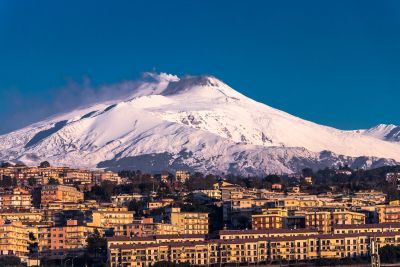Nell'articolo si parla dell'Etna, il vulcano più attivo di tutta Europa. Le eruzioni dell'Etna furono documentate in epoca greca e con gli antichi romani. Anche se gli abitanti corrono il rischio di vivere vicino al vulcano, il terreno intorno all'Etna è molto fertile e ottimo per l'agricoltura. È una destinazione popolare per i turisti e per gli scienziati. Il vulcano è un simbolo della forza e della bellezza della natura. È anche un simbolo di come la natura sia una cosa in continua evoluzione e imprevedibile.
Nestled on the enchanting island of Sicily, Italy, Mount Etna stands as a testament to the Earth's dynamic forces and captivates all who gaze upon its majestic slopes. As one of the most active and iconic volcanoes globally, Mount Etna holds a unique place in both the natural world and human history.
Mount Etna, towering at 10,922 feet, is Europe's highest and most active volcano. Its geological origins can be traced back to the convergence of the African and Eurasian tectonic plates, resulting in the subduction of the African plate beneath the Eurasian plate. This geological activity has given rise to the awe-inspiring stratovolcano that we marvel at today.
What sets Mount Etna apart is its frequent and often dramatic eruptions. The volcano is known for both effusive and explosive activity, contributing to its constantly changing landscape. The periodic lava flows down its slopes create a dynamic terrain, offering a stark contrast between the fertile foothills and the barren, moon-like surface near the summit.
Throughout history, Mount Etna's eruptions have been well-documented, dating back to ancient times. The Greeks, who settled in Sicily, revered the volcano, attributing its eruptions to the forge of Hephaestus, the god of fire and blacksmithing. The Romans, too, recognized the significance of Etna, with both Pliny the Elder and Strabo providing vivid descriptions of its eruptions.
Beyond its geological prowess, Mount Etna holds cultural and historical importance. The surrounding region is dotted with ancient settlements, and the volcanic soil has proven to be incredibly fertile for agriculture. The wines produced from the vineyards on the slopes of Etna are renowned for their unique flavors, owing much to the volcanic terroir.
While the frequent eruptions of Mount Etna pose challenges to the local communities, they also attract scientists, researchers, and curious visitors from around the globe. The volcano's activity is closely monitored, providing valuable insights into volcanic behavior and contributing to our understanding of Earth's dynamic processes.
Today, Mount Etna has become a popular tourist destination, drawing adventurers and nature enthusiasts seeking to witness the raw power of a living volcano. Guided tours allow visitors to explore the lower slopes, witness lava flows, and marvel at the panoramic views from the summit.
Mount Etna, with its towering presence and fiery temperament, remains an enduring symbol of nature's power. Its geological significance, cultural importance, and impact on the surrounding environment make it a fascinating subject of study and a breathtaking destination for those who dare to venture into its volcanic embrace. As Mount Etna continues to remind us of the Earth's ever-changing nature, it stands as a living testament to the beauty and unpredictability of the natural world.



